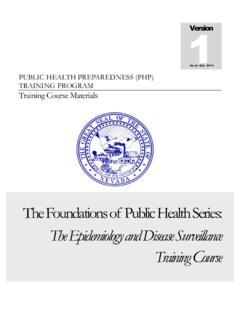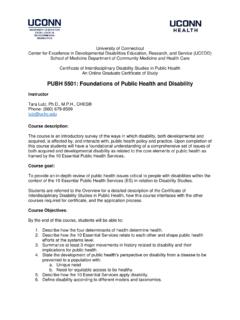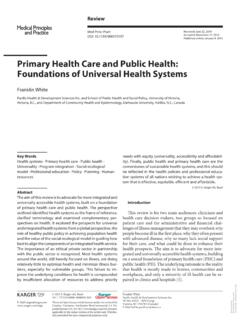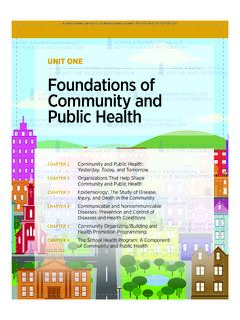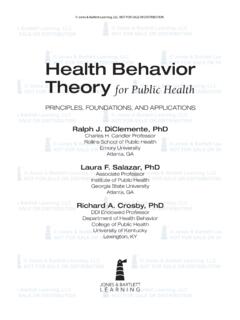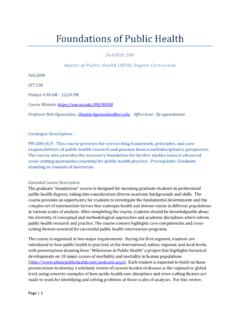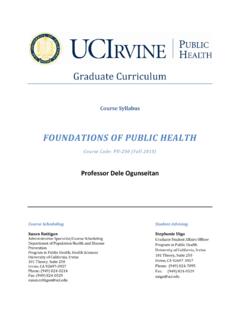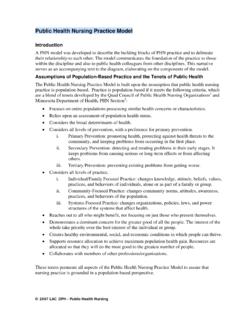Transcription of SCHOOLS FOR HEALTH
1 FOR HEALTH SCHOOLSFOUNDATIONS FOR STUDENT SUCCESSHOW SCHOOL BUILDINGS INFLUENCE STUDENT HEALTH , THINKING AND FOR HEALTH FOR HEALTH SCHOOLS FOR HEALTH report, SCHOOLS for HEALTH : foundations for Student Success was researched and produced by the Healthy Buildings program at the Harvard Chan School of public HEALTH under the direction of Dr. Joseph Allen. Our goal is to improve the lives of all people, in all buildings, everywhere, every day. The SCHOOLS for HEALTH program is a platform to discuss, research, and disseminate information on how school buildings affect the HEALTH and productivity of students, teachers, and staff every day. Our team works to answer critical questions related to the environmental and contextual factors that influence chronic absenteeism, academic performance, and short- and long-term HEALTH performance indicators.
2 SCHOOLS for HEALTH : foundations for Student Success is intended to serve as an evidence-based decision-making tool for key school Eitland, MPHL acey Klingensmith, MLAP iers MacNaughton, ScD, MSJose Cedeno Laurent, ScD, MSJack Spengler, PhDAri Bernstein, MD, MPHJ oseph G. Allen, DSc, MPHFor more information, contact Joseph G. Allen at Chan School of public HealthHarvard Center for HEALTH and the Global EnvironmentHealthy Buildings program FOR HEALTH FOR HEALTH FOR HEALTH SCHOOLSThe Questions We Ask About SchoolsWe ask about student:teacher ratios. We ask about test scores. We ask about the curriculum. We ask about start and end times, drop-off and pick-up routines, and bus schedules.
3 We ask about lunch, art and music programs, and the principal. We visit a classroom to meet a teacher or two. But has anyone, ever, asked about the school building?Building foundations for Student SuccessThis report makes the scientific case that the school building is foundational to student success, and is as important as all of these other factors we consider. + The evidence is unambiguous - the school building impacts student HEALTH , thinking and performance. + Investing in school buildings is an investment in our collective future. + It is time for action. It is time for SCHOOLS for HEALTH . SCHOOLS FOR HEALTH FOR HEALTH I.
4 EXECUTIVE II. The Importance of the School Building 21st Century Learning in 20th Century SCHOOLS Lessons from Recent History 9 foundations of a Healthy Building III. EXAMINING THE Ventilation and Indoor Air Quality Water Quality Thermal HEALTH Lighting and Views Acoustics and Noise Dust, Pests, Mold & Moisture Safety & Security IV. BEYOND THE 4 WALLS: CONTEXT Socioeconomic Status Existing HEALTH Access to Green Space Air Pollution Early Childhood Experiences V.
5 BUILDING A SCHOOL FOR THE 21ST The Urbanization Mega-Trend A Changing Climate A Call for Standardized HEALTH Performance Indicators (HPIs) A Call for a National School Infrastructure Assessment VI. SCHOOLS FOR Evidence for action When We Act It Makes a Difference The Evidence is Unambiguous VII. FOR HEALTH FOR HEALTH EXECUTIVE SUMMARY In the decade after the release of the landmark National Research Council report Green SCHOOLS : Attributes for HEALTH and Learning (National Research Council, 2007), the global research community has gathered extensive information and evidence to demonstrate that the school building is foundational to student success enough evidence to know that we can not afford to neglect the conditions of our SCHOOLS .
6 In recent years, numerous studies have emerged that show that the school environment can adversely or positively affect students well-being in multifaceted ways, both in the short term and over the course of their academic career. This report, SCHOOLS for HEALTH : foundations for Student Success, reviews findings from more than 200 scientific studies and identifies more than 70 HEALTH Performance findings provide robust public HEALTH evidence that environmental exposures in school buildings can impact student HEALTH , student thinking and student performance. Studies show that environmental factors within and around the school building can interact with each other in complex ways. Thus, the school building itself, where students spend a significant portion of their childhood, represents a prime opportunity to intervene and protect the HEALTH of children, our most vulnerable citizens.
7 STUDENT THINKINGSTUDENT HEALTHSTUDENT PERFORMANCED espite growing recognition of the importance of environmental HEALTH in SCHOOLS , the national investment in public school facilities in the United States continues to fall short by $46 billion a year. Consequently, many SCHOOLS are left underfunded and unable to make much-needed upgrades to deteriorating buildings. Millions of K 12 students in America spend several hours a day learning in SCHOOLS that are more than 50 years old and in need of extensive repair and where children may be exposed to mold, poor ventilation, uncomfortable temperatures, inadequate lighting, and overcrowded, excessively noisy conditions. These adverse circumstances can disadvantage students who already struggle on a daily basis.
8 Children are not little adults. They have unique needs, sensitivities, and vulnerabilities, and it is becoming increasingly evident that current school building conditions may not be sufficiently protective of our students developing bodies and minds. A large body of research has demonstrated that the school building influences their success as much as any other factor. Now it is time to act on behalf of our children and teachers, who deserve to develop, learn, and thrive in a healthy environment that optimizes their potential to succeed. The scientific literature provides overwhelming evidence of the benefits of healthy school buildings. And evidence that when we act, we see an immediate difference.
9 In this report we make two recommendations. First, we make a call for standardized HEALTH Performance Indicators so that we can continue to understand the key drivers of HEALTH and performance in SCHOOLS . Second, recognizing that school facilities represent the second largest sector of public infrastructure spending after highways, we call for a National Director of School Infrastructure and a National School Infrastructure FOR HEALTH FOR HEALTH INTRODUCTIONThe Importance of the School BuildingThe quality and characteristics of our SCHOOLS have an outsized impact on the HEALTH of students. By the time a student graduates from high school, she or he has spent 15,600 hours inside a school, an amount of time second only to that spent at home.
10 For more than 50 million K 12 students in the United States, the time spent in school is also a time of rapid physical growth, hormonal changes, intense learning, and critical neurological and social development. Unfortunately, many aspects of the HEALTH and performance of students can be negatively affected by chronic exposures to common environmental factors in school buildings, including indoor air pollution, mold, pests, pesticides, radon, asbestos, lead, inadequate lighting, and elevated noise levels. The EPA (2011) has estimated that more than 60,000 SCHOOLS ( , 46% of public SCHOOLS ) have environmental conditions that contribute to poor IEQ, including many of these factors. Although there is growing recognition that children s HEALTH is foundational to their ongoing success in the classroom and beyond, increasing numbers of American students are burdened with ailments that challenge their ability to be present and fully engaged at school.


